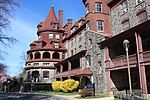Bryn Mawr College
1885 establishments in PennsylvaniaBryn Mawr CollegeEastern Pennsylvania Rugby UnionEducational institutions established in 1885Gothic Revival architecture in Pennsylvania ... and 10 more
Historic districts on the National Register of Historic Places in PennsylvaniaLiberal arts colleges in PennsylvaniaLower Merion Township, PennsylvaniaNRHP infobox with nocatNational Register of Historic Places in Montgomery County, PennsylvaniaPrivate universities and colleges in PennsylvaniaQuaker universities and collegesSchool buildings on the National Register of Historic Places in PennsylvaniaSeven Sister CollegesUniversities and colleges in Montgomery County, Pennsylvania
Bryn Mawr College ( brin-MAR; Welsh: [ˌbɾɨ̞nˈmau̯ɾ]) is a women's liberal arts college in Bryn Mawr, Pennsylvania. Founded as a Quaker institution in 1885, Bryn Mawr is one of the Seven Sister colleges, a group of elite, historically women's colleges in the United States, and the Tri-College Consortium along with Haverford College and Swarthmore College. The college has an enrollment of about 1,350 undergraduate students and 450 graduate students. It was the first women's college to offer graduate education through a PhD.
Excerpt from the Wikipedia article Bryn Mawr College (License: CC BY-SA 3.0, Authors).Bryn Mawr College
Airdale Road, Lower Merion Township
Geographical coordinates (GPS) Address External links Nearby Places Show on map
Geographical coordinates (GPS)
| Latitude | Longitude |
|---|---|
| N 40.026388888889 ° | E -75.313611111111 ° |
Address
Bryn Mawr College
Airdale Road
19010 Lower Merion Township
Pennsylvania, United States
Open on Google Maps






